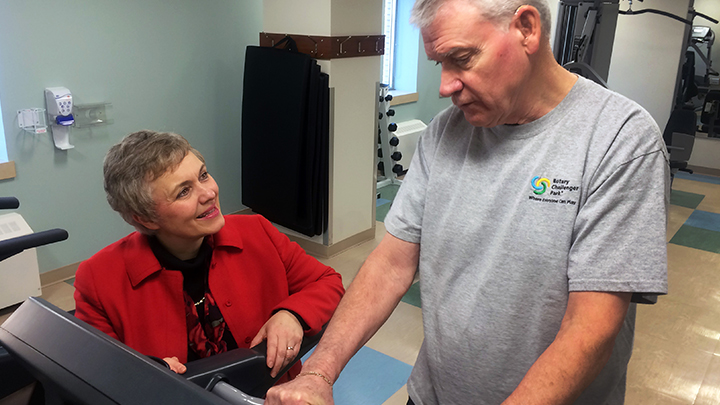
March 24, 2016

Dr. Christine Friedenreich, an AHS cancer researcher who has extensively studied the positive impact of increased exercise for men with prostate cancer, watches as prostate-cancer survivor Colin Cantlie rides an exercise bike.
Story and photo by Greg Harris
CALGARY — No one has to tell Colin Cantlie about the benefits of staying physically active in the face of a prostate cancer diagnosis.
The 74-year-old Calgary man, who underwent surgery to remove his prostate gland two years ago, says his recovery wouldn’t have been as smooth without exercise.
“I’m not an athlete by any means but I’ve always been one to enjoy exercise,” says Cantlie. “If I hadn’t been physically active after surgery, I think my attitude would have gone downhill and my recovery would have been more difficult. You need to exercise after surgery to help your body recover.”
Now, researchers with Alberta Health Services (AHS) have shown that men with prostate cancer who are physically active survive longer than men who are inactive.
Spanning 17 years and tracking more than 800 patients, the study is one of the first large-scale epidemiological investigations of the effects of physical activity in prostate cancer patients.
“Our goal was to see how physical activity done before and after diagnosis was related to survival,” says Dr. Christine Friedenreich, AHS Scientific Leader, Cancer Epidemiology and Prevention Research.
Friedenreich has also extensively researched the impact of increased exercise in breast cancer prevention and survival.
“When I started looking at this topic in the 1990s there was still a lot of hesitation about recommending exercise to patients, but the evidence has definitely accumulated since then,” she says. “Physical activity is a modifiable lifestyle risk factor; it’s something that everyone can control and incorporate into their lives.”
The study gives the most comprehensive assessment of physical activity done before and after diagnosis of any study ever conducted. Dr. Friedenreich and her team assessed lifetime physical activity up to diagnosis, and then did three followup assessments of activity after diagnosis.
The findings show that men who actively participate in recreational activities after diagnosis are at significantly lower risk of dying from prostate cancer, or from any other cause, than are inactive men. Researchers also found that men who are physically active prior to a prostate cancer diagnosis also survive longer.
In measuring physical activity, researchers took into account occupational, household and recreational activities.
“All types of physical activity are important, not just vigorous exercise or sports,” says Dr. Friedenreich. “Even going for a brisk 30-minute walk three times a week has measurable benefits.”
About 2,200 men in Alberta are diagnosed with prostate cancer every year. It’s the most common cancer for men, followed by lung and colon cancer, and the third most deadly cancer after colorectal and lung cancer. Treatment can include radiation, chemotherapy or surgery.
Dr. Friedenreich expects her study will help lay the groundwork for future research where exercise is studied as an intervention in helping men with prostate cancer improve both their recovery from treatment and their survival.
“The next step is trying to understand what the appropriate dose and type of physical activity is needed to reduce risks after being diagnosed with prostate cancer,” says Dr. Friedenreich. “We need the research evidence that can be used to develop physical activity recommendations for cancer survivors.”
In Calgary, men with prostate cancer can access nutrition and exercise programs through the Prostate Cancer Centre at Rockyview Hospital and other wellness organizations.